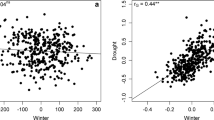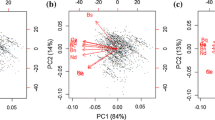Abstract
Genetic models for quantitative traits of triploid endosperms are proposed for the analysis of direct gene effects, cytoplasmic effects, and maternal gene effects. The maternal effect is partitioned into maternal additive and dominance components. In the full genetic model, the direct effect is partitioned into direct additive and dominance components and high-order dominance component, which are the cumulative effects of three-allele interactions. If the high-order dominance effects are of no importance, a reduced genetic model can be used. Monte Carlo simulations were conducted in this study for demonstrating unbiasedness of estimated variance and covariance components from the MINQUE (0/1) procedure, which is a minimum norm quadratic unbiased estimation (MINQUE) method setting 0 for all the prior covariances and 1 for all the prior variances. Robustness of estimating variance and covariance components for the genetic models was tested by simulations. Both full and reduced genetic models are shown to be robust for estimating variance and covariance components under several situations of no specific effects. Efficiency of predicting random genetic effects for the genetic models by the MINQUE (0/1) procedure was compared with the best linear unbiased prediction (BLUP). A worked example is given to illustrate the use of the reduced genetic model for kernel growth characteristics in corn (Zea mays L.).
Similar content being viewed by others
References
Beavis WD, Pollak E, Frey KJ (1987) A theoretical model for quantitatively inherited traits influenced by nuclear-cytoplasmic interactions. Theor Appl Genet 74:571–578
Bogyo TP, Lance RCM, Chevalier P, Nilan RA (1988) Genetic models for quantitatively inherited endosperm characters. Heredity 60:61–67
Cockerham CC, Weir BS (1977) Quadratic analyses of reciprocal crosses. Biometrics 33:187–203
Dhaliwal HS (1977) Genetic control of seed proteins in wheat. Theor Appl Genet 50:235–239
Eisen EJ, Hórstgen-Schwark G, Saxton AM, Bandy TR (1983) Genetic interpretation and analysis of diallel crosses with animals. Theor Appl Genet 65:17–23
Foolad MR, Jones RA (1992) Models to estimate maternally controlled genetic variation in quantitative seed characters. Theor Appl Genet 83:360–366
Gale MD (1975) High-amylase breeding and genetical aspects of the problem. Cereal Res Commun 4:231–243
Garwood DL, Weber RJ, Lamber RJ, Alexander DE (1970) Effect of different cytoplasm on oil, fatty acids, plant height, and ear height in maize (Zea mays L.). Crop Sci 10:39–41
Griffing B (1956) Concept of general and specific combining ability in relation to diallel crossing systems. Aust J Biol Sci 9:463–493
Henderson CR (1948) Estimation of general, specific and maternal combining abilities in crosses among inbred lines of swine. PhD thesis, Iowa State University, Ames, Iowa
Kofoid KD, Maan SS (1982) Agronomic and bread-making performance of fertile alloplasmic wheat. Crop Sci 22:725–729
Mo H (1988) Genetic expression for endosperm traits. In: Weir BS, Eisen EJ, Goodman MM, Namkoong GN (eds) Proc 2nd Int Conf Quant Genet. Sinauer Assoc, Boston Mass., pp 478–487
Poneleit CG, Bauman LF (1970) Diallel analysis of fatty acids in corn (Zea mays L.) oil. Crop Sci 10:338–341
Poneleit CG, Egli DB (1983) Differences between reciprocal crosses of maize for kernel growth characteristics. Crop Sci 23:871–875
Rao AP, Fleming AA (1978) Cytoplasmic-genotypic effects in the GT 112 maize inbred with four cytoplasms. Crop Sci 18:935–937
Ullrich SE, Eslick RF (1978) Protein and lysine maternal inheritance effects in high protein and high lysine barley mutant Hiproly. Barley Genet Newsl 8:108–109
Weber EJ (1983) Variation in corn (Zea mays L.) for fatty acid compositions of triglycerides and phospholipids. Biochemical Genet 21:1–13
Zhu J, Weir BS (1994) Analysis of cytoplasmic and maternal effects. I. A genetic model for diploid plant seeds and animals. Theor Appl Genet (in press)
Author information
Authors and Affiliations
Additional information
Communicated by A. L. Kahler
Rights and permissions
About this article
Cite this article
Zhu, J., Weir, B.S. Analysis of cytoplasmic and maternal effects. II. Genetic models for triploid endosperms. Theoret. Appl. Genetics 89, 160–166 (1994). https://doi.org/10.1007/BF00225136
Received:
Accepted:
Issue Date:
DOI: https://doi.org/10.1007/BF00225136




